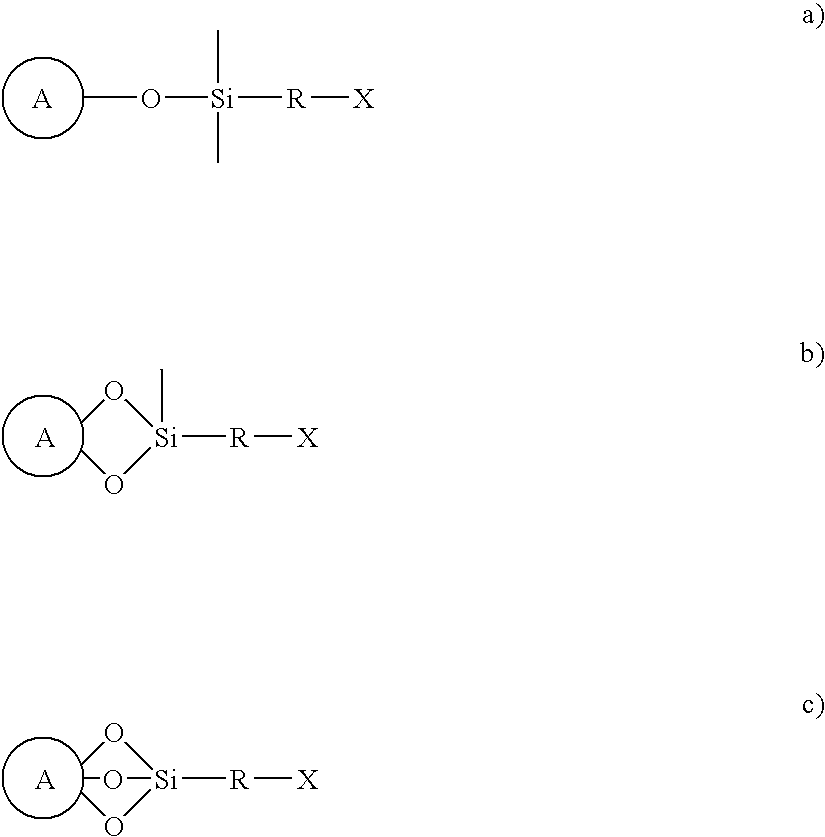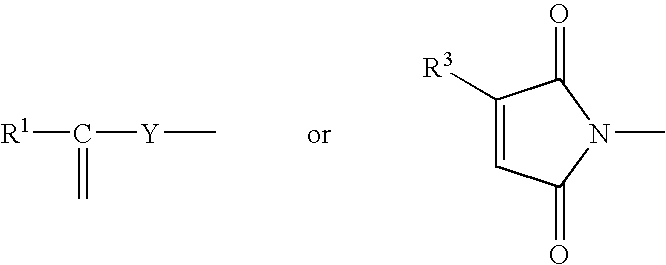High-temperature resistant polymerizable metal oxide particles
a metal oxide and high temperature resistant technology, applied in the field of high-temperature resistant polymerizable metal oxide particles, can solve the problems of lack of reproducible structures and properties, and limited use of nano-scale materials
- Summary
- Abstract
- Description
- Claims
- Application Information
AI Technical Summary
Problems solved by technology
Method used
Image
Examples
examples 1 to 15
The raw materials and compositions of the particles of the invention are evident from Table 1, while the preparation is described below.
The respective comonomer is charged to a stirred vessel and heated to the predetermined reaction temperature. When the reaction temperature has been reached, the stated amounts of core material A and the compounds B--X are introduced alternately into the liquid comonomer with intensive stirring and are distributed homogeneously. Subsequently, water and the amounts of wetting agent and catalyst as per Table 1 are added with stirring over 15 minutes. Subsequently, stirring is continued at the respective reaction temperature. Finally, the reaction mixture is neutralized, if appropriate, with 50% strength aqueous sodium hydroxide solution over about 15 minutes and the reaction mixture is cooled to room temperature. In Example 11, there is no need for an initial comonomer charge. In this case, MH 15 is introduced as initial charge.
example 16
A stirred vessel (2l) equipped with stirrer, dropping funnel and reflux condenser is charged with 100 pbw of HDK 600 and / or HDA in 1 l of acetone. The mixture is heated at boiling with intensive stirring. Then, with stirring continuing, 50 pbw of MEMO followed by 1.5 pbw of maleic anhydride dissolved in 10 pbw of water are added. Heating is continued for 2 hours under reflux. Finally, the solvent is distilled off under reduced pressure (1.6 kPa) at 30.degree. C. The resulting nanopowder is subsequently comminuted or micronized. The yield is virtually quantitative.
example 17
30.0 pbw of HDK 100 were pasted up in 10.0 pbw of GMA and subsequently mixed with 60.0 pbw of a mixture consisting of 12% by weight TMPTA and 88% by weight TETMPTA. This mixture is ground in a Fritsch planetary ball "Pulverisette 5" using zirconium(IV) oxide beads (4 beads .O slashed. 20 mm; 15 beads .O slashed. 10 mm; milling beaker volume 75 ml) at a milling beaker rotational speed of 360 min.sup.-1 for 45 minutes. Subsequently, 0.2 ml of 70% strength aqueous perchloric acid is added dropwise to effect covalent attachment to the core material A by way of the epoxy group of the GMA. After further milling for approximately 20 minutes, the colloidal dispersion obtained may be processed in accordance with known methods. Regarding its properties, see Table 2.
PUM
| Property | Measurement | Unit |
|---|---|---|
| glass transition temperature | aaaaa | aaaaa |
| particles size | aaaaa | aaaaa |
| specific surface area | aaaaa | aaaaa |
Abstract
Description
Claims
Application Information
 Login to View More
Login to View More - R&D
- Intellectual Property
- Life Sciences
- Materials
- Tech Scout
- Unparalleled Data Quality
- Higher Quality Content
- 60% Fewer Hallucinations
Browse by: Latest US Patents, China's latest patents, Technical Efficacy Thesaurus, Application Domain, Technology Topic, Popular Technical Reports.
© 2025 PatSnap. All rights reserved.Legal|Privacy policy|Modern Slavery Act Transparency Statement|Sitemap|About US| Contact US: help@patsnap.com



